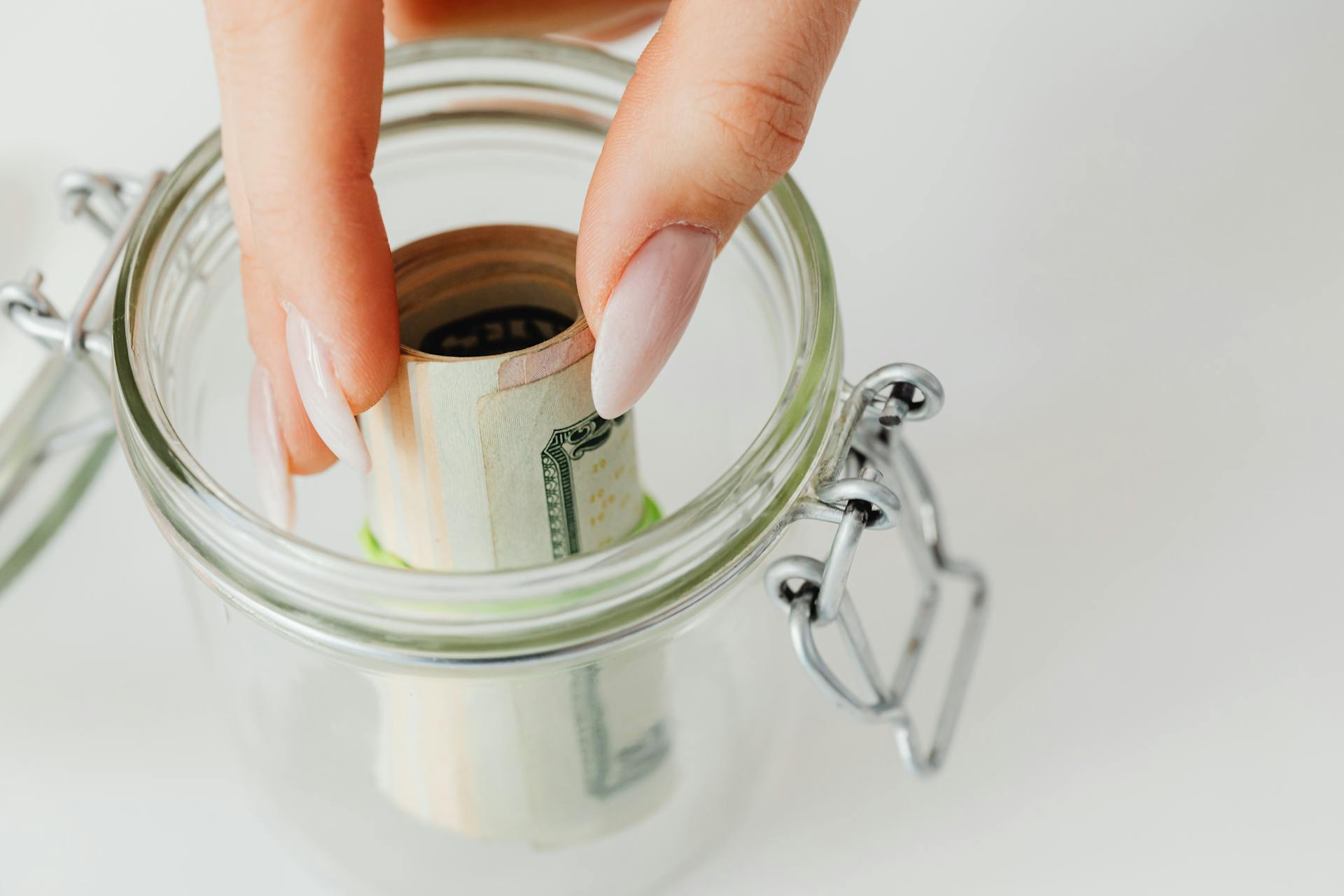
The Bulgarian Lev is the official currency of Bulgaria, and it's a great idea to understand how it works if you're planning a trip to the country. The Lev is subdivided into 100 stotinks, but don't worry too much about those - you'll rarely need to use them.
You can find Bulgarian Lev in various denominations, including 2, 5, 10, 20, 50, and 100 lev notes. The currency is pegged to the euro, which means the exchange rate is fixed.
As of 2022, the Bulgarian Lev is available in various forms, including cash, credit cards, and online payments. You can exchange your money for Lev at a bank or currency exchange office, or withdraw it from an ATM using your debit or credit card.
History of Bulgarian Lev
The Bulgarian lev has a rich history that spans over a century. Introduced in 1881, the lev was initially pegged to the French franc, with a value equivalent to one French franc.
Suggestion: Bulgarian Lev into Pounds
The lev underwent several redenominations, with the most significant one occurring in 1952, when the new lev replaced the original lev at a rate of 1 "new" lev = 100 "old" leva. This change was necessary due to wartime inflation.
During World War II, the lev was pegged to the German Reichsmark and later to the Soviet ruble. After the war, the lev was pegged to the U.S. dollar, with the rate fluctuating over time.
Here's a brief overview of the four distinct periods of the Bulgarian lev:
- The first lev was introduced in 1881 and was pegged to the French franc.
- The second lev was introduced in 1952, following wartime inflation, and was pegged to the U.S. dollar.
- The third lev was introduced in 1962 and remained stable for nearly 30 years, with gold backing until 1989.
- The fourth lev was introduced in 1999, with a redenomination at 1000:1, and is currently pegged to the euro.
Etymology
The name "Lev" comes from the archaic Bulgarian word for lion. This name has been associated with the currency since its inception.
The lion has been a national symbol of Bulgaria for centuries, with images of the animal appearing in various historical monuments and artifacts.
In Bulgaria, the lion features in numerous historical monuments, including the Madara Horseman, a medieval rock relief carved into a towering rock plateau in northeastern Bulgaria. This 7th or 8th century AD monument is on UNESCO's World Heritage List.
The lion was also celebrated as a symbol of power by Bulgarian kings, such as Ivan Shishman, one of the last rulers of the Second Bulgarian kingdom.
During the time of Bulgarian national awakening, the lion was widely used as a major national symbol, appearing on revolutionary flags and in folklore and literature.
First Level (1881–1952)
The first lev was introduced in 1881, valued at the same rate as the French franc. It was a new currency for Bulgaria, marking the beginning of a long history.
The first lev was pegged to the French franc, but it didn't take long for the gold standard to be suspended between 1899 and 1906, and again in 1912. This meant the currency's value was no longer directly tied to gold.
Until 1916, Bulgarian coins were issued to the same specifications as those of the Latin Monetary Union, which was a group of European countries that shared a common currency system. This was a significant milestone in Bulgarian currency history.
Banknotes issued until 1928 were backed by gold or silver, with specific denominations known as "leva zlato / zlatni" and "leva srebro / srebarni". This added an extra layer of security and stability to the currency.
In 1928, a new gold standard was established, with 1 lev equal to 10.86956 mg of gold. This was a significant change to the currency's value and paved the way for future developments.
During World War II, the lev was pegged to the German Reichsmark at a rate of 32.75 leva = 1 Reichsmark, and later to the Soviet ruble at 15 leva = 1 ruble. This was a tumultuous time for the currency, with multiple changes in its value.
Here's a brief summary of the first lev's history:
The first lev's history was marked by significant changes in its value and pegs to other currencies. This laid the groundwork for the development of the second lev, which would introduce new denominations and a new era for the Bulgarian currency.
Fourth Level (1999-Present)
The fourth period of the Bulgarian lev began on July 5, 1999, with a redenomination at 1000:1.
This redenomination replaced the old lev with a new one, where 1 new lev was equal to 1 Deutsche Mark. The ISO 4217 currency code for the new lev is BGN.
The new lev was pegged to the euro at a fixed exchange rate of 1.95583 leva for one euro. This rate continued the fixed exchange rate from the third lev, which was pegged to the Deutsche Mark.
The pegged exchange rate is a result of Bulgaria's previous currency pegs, including the one to the German Reichsmark during World War II and the Soviet ruble during the Soviet occupation.
Here are the key dates for the fourth period of the Bulgarian lev:
The new lev has been a stable currency, and Bulgaria's intention to convert to the euro has been delayed into the 2020s.
Notes
The Bulgarian Lev has had a fascinating history, and there are a few key notes worth mentioning.
The Lev was first introduced as a replacement for the Bulgarian Lev of 1881.
In 1952, the Bulgarian government decimalized the currency, introducing the Lev as the official currency.
The Lev was pegged to the Soviet Ruble at a rate of 1 Lev to 0.87 Rubles.
The Bulgarian government decimalized the currency again in 1962, introducing a new series of Lev banknotes and coins.
Bulgarian Lev
The Bulgarian lev is the national currency of Bulgaria, and it's been in use since 1881. The current version has been in circulation since 1999.
You'll recognize the currency code BGN and the symbol лв when you're in Bulgaria. The lev is pegged to the euro at a rate of EUR/BGN 1.95583.
Bulgaria is expected to adopt the euro as its currency in 2024, according to the government's statement in May 2022.
For more insights, see: Euro in Bulgarian Lev
Coins
The Bulgarian lev has a fascinating history, especially when it comes to its coins. The first coins were introduced between 1881 and 1884, featuring bronze 2, 5, and 20 stotinki, and silver 50 stotinki, 1, 2, and 5 leva.
You'll notice that the stotinki coin comes in various denominations, including 1, 2, 5, 10, 20, and 50 stotinki.
In 1901, bronze 1 stotinka coins were introduced. The production of silver coins ceased in 1916, with zinc replacing cupro-nickel in the 5, 10, and 20 stotinki in 1917.
A different take: 1 Usd Qatari Riyal
Banknotes
The Bulgarian lev has a fascinating history of banknotes. The Bulgarian National Bank introduced notes for 20 and 50 gold leva in 1885.
In 1887, 100 gold leva notes were introduced, followed by 5 and 10 gold leva notes in 1890. You'll find that the early notes were designated as gold or silver leva.
The 1899 issue of 5, 10, and 50 silver leva notes marked a significant development. These notes were followed by 100 and 500 silver leva in 1906 and 1907, respectively.
500 gold leva notes were also introduced in 1907, and in 1916, 1 and 2 silver leva and 1000 gold leva notes were introduced. This series of notes was notable for its large denominations.
In 1924, 5000 leva notes were issued, the first to lack a metal designation. The introduction of these notes marked a shift towards a more standardized system.
In 1928, a new series of notes was introduced, which gave the denominations solely in leva. This series included denominations of 5, 10, 20, 50, 100, 500, 1000, and 5000 leva.
For another approach, see: Whats Mexican Money Called
Bulgarian Currency
The Bulgarian Lev is the official currency of Bulgaria, and it's been in use since 1881. It's abbreviated as BGN and symbolized by лв.
You can find Bulgarian banknotes in denominations of 1, 2, 5, 10, 20, 40, and 100 leva, although the 1 BGN note is seldom used. There's also a 1 lev coin.
The stotinki comes in coins of 1, 2, 5, 10, 20, and 50. Between 1881 and 1884, bronze 2, 5, and 20 stotinki, and silver 50 stotinki, 1, 2, and 5 leva were introduced.
If you're planning to visit Bulgaria, it's a good idea to have Bulgarian levs with you. ATMs are available in Bulgaria's big cities and towns, with a normal limit per withdrawal of around BGN400.
Here's a list of Bulgarian banknote denominations:
- 1 leva
- 2 leva
- 5 leva
- 10 leva
- 20 leva
- 40 leva
- 100 leva
The Bulgarian Lev is pegged to the euro at a rate of EUR/BGN 1.95583, and Bulgaria is an EU member since 2007. It's expected to adopt the euro as its currency in 2024, based on the government's most recent statement in May 2022.
Frequently Asked Questions
How much lev should I take to Bulgaria?
For meals and transportation, consider budgeting 35-45 lev per person per day in Bulgaria. This daily amount will help you navigate the country's costs, but it's always a good idea to research specific expenses for your travel plans.
Is the Bulgarian Lev a strong currency?
The Bulgarian Lev is a relatively strong currency, with a stable exchange rate of around 1.78 to the US dollar. Its value may be worth considering when planning a trip or investment in Bulgaria.
Why is Bulgarian lev so strong?
The Bulgarian lev is strong because it's pegged to the euro at a fixed exchange rate, backed by euro reserves, and fully convertible. This currency board system gives the lev stability and trust, making it a reliable choice.
What does BGN stand for in Bulgaria?
BGN stands for Bulgarian Lev, the official currency of Bulgaria. It's the country's local currency, used alongside the euro in EU member state Bulgaria.
Featured Images: pexels.com


